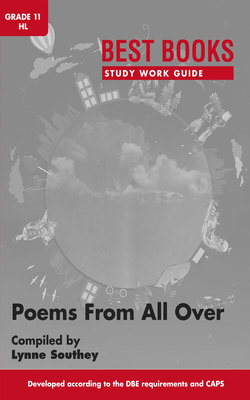Читать книгу Best Books Study Work Guide: Poems From All Over Gr 11 HL - Lynne Southey - Страница 19
Anthem for Doomed Youth by Wilfred Owen
Оглавление(See p. 31 in Poems From All Over)
| Title: | An anthem is, for example, the proud song of a nation. The title therefore points to a contradiction in that a generation of youth are “doomed”, fated to die. |
| Theme: | The horror of war. |
| Mood: | Sombre, anguished. |
Discussion
The poem, written during the First World War (1914–1918), in which the poet himself was fighting and so had first-hand experience of, is about the deaths of countless young soldiers. He compares their dying to the way cattle die in an abattoir, and lists the things they do not have that are normally given to the ceremony of a funeral.
The poem contain fourteen lines, and so is a sonnet with an octet and sestet, but it breaks from the normal conventions, jarring the reader’s expectations and so pointing to the dissonance that is war.
This poem is particularly poignant if one is aware of the poet’s own life. He himself was one of the “doomed youth” he speaks about, dying in the war, although he did not know it at the time, of course.
Analysis
| Lines | Comment | |
| 1–4 | The first line asks a question: what kind of death bells are these that are being rung, and for people dying in a way that suggests slaughter? The next line describes the “these” of the first line: not the sound of bells but the sound of guns. And then instead of prayers (“orisons”) normally said at a funeral, the dead have the sound of rifle fire. | Cattle are raised to serve as meat and are simply sent to be killed when their time has come. These soldiers are used in a similar way: sent out to serve as “cannon fodder”, to fight an enemy, without thought to individual lives and all that they mean.Notice the “monstrous” (line 2) anger, an adjective that suggests something unnatural, and the aptness of “patter” (line 4) to describe the “rapid rattle” (line 3) of the “rifles”. The sound effects here are vivid. Also the word “hasty” (line 4) points to the urgency of the battle, where no one has time to stop and mourn another’s death. |
| 5–8 | These lines describe what is usually present at a funeral, but are missing for these youths killed: “prayers”, “bells”, “voice of mourning” and “choirs”. What they have instead is a “choir of wailing shells; / And bugles”. | The negatives “No”, “no”, “Nor” point to the normal funeral rites missing for these dead. What they do have instead is likened to some of these rites: “wailing shells” and “bugles” are the sounds heard in war. The reference to “sad shires” brings in the idea of families, the soldiers’ parents and loved ones, who also suffer when their young men are killed. It expands the idea of the suffering caused by war.The caesura (break in the middle of a line) in line 5 causes a pause: they have ceased to be. It reinforces the meaning of this.An interpretation that can be given to “mockeries” is that the normal burial rites are part of the Christian ceremony, and that this word points to a god who allows such suffering, as if the poet is calling out “where is God in all this?” |
| 9–14 | The sestet continues to mention elements of a funeral that are missing here: “candles”, “pall”, “flowers” and “drawing-down of blinds”. Instead the dead have the eyes of the still-living soldiers full of feeling (“glimmers”), the mourning faces of young girls left behind as coffin cloths (“palls”), and their quietly waiting thoughts (“patient minds”) as flowers. For blinds that are usually drawn in a house to signify that someone has died, they will have night falling. | Here, “speed them all” (line 9) seems to refer to the idea that souls of the dead journey to heaven, with the candles of the church and mourners lighting the way for them.A funeral is a way of saying goodbye to the dead; here they have their fellow soldiers doing this. Bringing in “girls” and “drawing-down of blinds” (line 14) includes those left at home, sweethearts and families who also suffer during a war.“And each slow dusk” emphasises that these senseless deaths happen every day, every nightfall is the blinds being drawn for those killed that day. This emphasises the extent of the slaughter. |
Contextual questions
1.Write out the rhyme scheme of the sonnet. Would you say that this is regular or irregular? (3)
2.Write out all the adjectives used in the poem, and comment on them. (7)
3.What is the effect of the repeated “Only” that begins line 2 and 3? (2)
4.The “save” in line 6 means what here? What other connotations does the word have that could apply in the context of the poem as a whole? (3)
5.This poem is anti-war. Do you support the view or can you justify war? (5)
(20)
| Enrichment activityFind and read other war poems of this time and compare them with this one. Examples of poets are Rupert Brooke, Wilfred Owen (an English poet and a soldier in the First World War) and Siegfried Sassoon (an English poet and a soldier in the First World War). |
